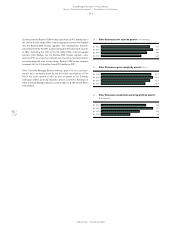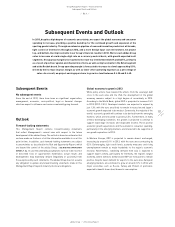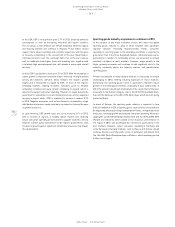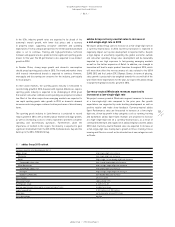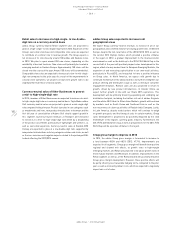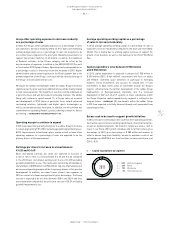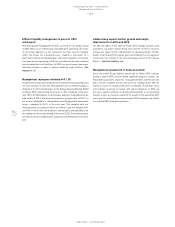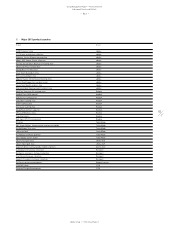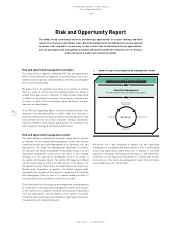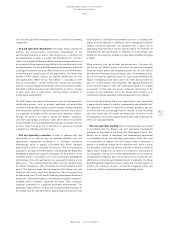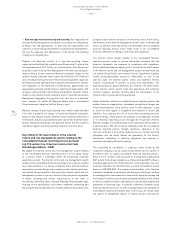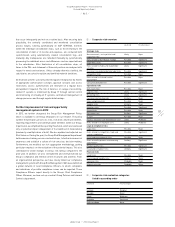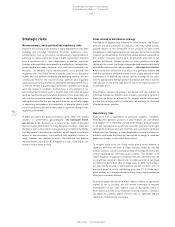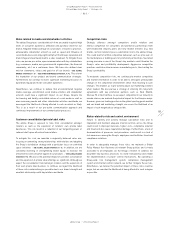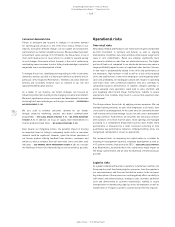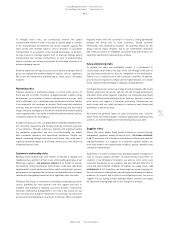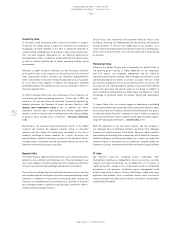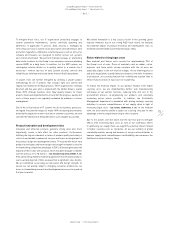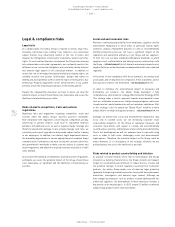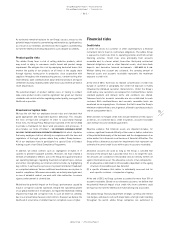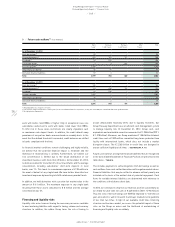Reebok 2012 Annual Report Download - page 188
Download and view the complete annual report
Please find page 188 of the 2012 Reebok annual report below. You can navigate through the pages in the report by either clicking on the pages listed below, or by using the keyword search tool below to find specific information within the annual report.
adidas Group
/
2012 Annual Report
Group Management Report – Financial Review
166
2012
Risk and Opportunity Report
/
03.5
/
/
Risk and opportunity monitoring and reporting: Our integrated risk
and opportunity management system aims to increase the transparency
of Group risks and opportunities. As both risks and opportunities are
subject to constant change, Risk Owners not only monitor developments,
but also the adequacy and effectiveness of the current risk handling
strategy on an ongoing basis.
Regular risk reporting consists of a two-step reporting stream
supported and facilitated by a globally used Group-wide IT solution that
was implemented in 2011. Firstly, on a quarterly basis, Risk Owners are
required to report to Group Risk Management risks with a possible gross
impact rating of at least moderate (financial equivalent: impact on the
relevant income statement metric above the threshold of € 10 million)
and a net impact rating of at least minor (financial equivalent: impact on
the relevant income statement metric above the threshold of € 1 million),
both regardless of the likelihood of materialising. Opportunities are
aggregated separately, with Risk Owners reporting all opportunities with
an impact rating of at least minor (financial equivalent: above € 1 million
impact on the relevant income statement metric). Secondly, Group Risk
Management aggregates the reported risks and, also on a quarterly
basis, provides the adidas AG Executive Board with a consolidated
Group-wide report based on the Risk Owners’ input.
Material changes in previously reported risks and/or newly identified
risks with a potential net impact of moderate (financial equivalent:
impact on the relevant income statement metric above the threshold of
€ 10 million), and any issues identified which due to their material nature
require immediate reporting to the Executive Board, are also reported
outside the regular quarterly reporting stream on an ad hoc basis.
Description of the main features of the internal
control and risk management system relating to the
consolidated financial reporting process pursuant
to § 315 section 2 no. 5 German Commercial Code
(Handelsgesetzbuch – HGB)
We regard the internal control and risk management system relating
to the consolidated financial reporting process of the adidas Group
as a process which is embedded within the Group-wide corporate
governance system. The internal control and risk management system
relating to the consolidated financial reporting process aims at avoiding
false representation in our Group accounting and in external financial
reporting by ensuring Group-wide compliance with statutory provisions
and internal Group regulations. We regard the internal control and risk
management system as a process based on the principle of segregation
of duties, encompassing various sub-processes in the areas of
Accounting, Controlling, Taxes, Treasury, Planning, Reporting and Legal,
focusing on the identification, assessment, treatment, monitoring and
reporting of financial reporting risks. Clearly defined responsibilities are
assigned to each distinct sub-process in the various areas. In a first step,
the internal control and risk management system serves to identify and
assess as well as to limit and control risks identified in the consolidated
financial reporting process which might result in our consolidated
financial statements not being in conformity with regulations.
The internal control system relating to the consolidated financial
reporting process serves to provide reasonable assurance that the
financial statements are prepared in compliance with regulations
despite identified financial reporting risks. To monitor the effectiveness
of the internal control and risk management system, Internal Audit and
our central Group Policies and Internal Controls department regularly
review accounting-relevant processes. Additionally, as part of the
year-end audit, the external auditor selects and examines internal
controls, including the IT systems, to assess their effectiveness. The
Supervisory Board’s Audit Committee also monitors the effectiveness
of the internal control system. Even with appropriate and functional
systems, however, absolute certainty about the effectiveness of the
internal control system cannot be guaranteed.
adidas AG defines uniform consolidated financial reporting policies and
updates these on a regular basis, dependent on regulatory changes and
internal developments. Clear policies serve to limit employees’ scope
of discretion with regard to recognition and valuation of assets and
liabilities, thus reducing the risk of inconsistent accounting practices
within the Group. These policies are available to all employees involved
in the financial reporting process through the Group-wide intranet.
Material changes are communicated to the subsidiaries Group-wide on
a quarterly basis. We aim to ensure compliance with the consolidated
financial reporting policies through continuous adherence to the
four-eyes principle in accounting-related processes. Certain reporting
obligations and the extent thereof are mandatory for the Group’s
subsidiaries. Adherence to reporting obligations and timelines is
monitored centrally by Group Accounting.
The accounting at subsidiaries is conducted either locally by the
respective company or by an adidas Group Shared Service Centre, in
accordance with our global consolidated financial reporting policies.
Most of the IT systems used are based on a Group-wide standardised
SAP system. Some Group companies use Navision-based ERP software.
Following approval by the Finance Director of the subsidiary, the local
financial statements are transferred into a central consolidation system
based on SAP SEM-BCS. The regularity and reliability of the financial
statements prepared by subsidiaries and adjusted to the Group’s uniform
accounting policies are reviewed at Group level by Group Accounting and
Controlling. These measures include automated validation in the system
as well as creation of reports and analyses to ensure data integrity and
adherence to reporting logic. In addition, differences between actual
financial data and prior year as well as budget figures are analysed on
a distribution channel and market level. If necessary, the Group seeks
the opinion of independent experts to review business transactions


